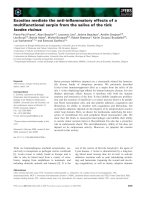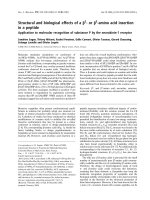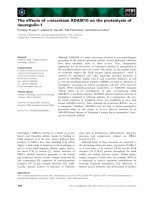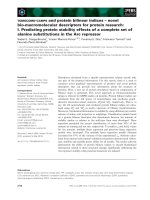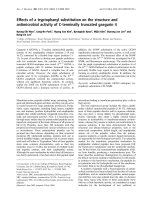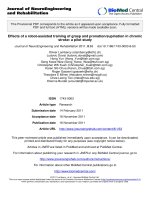Sequential effects of a high fat, calorie dense diet or a high fiber diet on gene expression, body weight and associated metabolic responses in c57 BL6J mice
Bạn đang xem bản rút gọn của tài liệu. Xem và tải ngay bản đầy đủ của tài liệu tại đây (3.57 MB, 228 trang )
SEQUENTIAL EFFECTS OF A HIGH-FAT,
CALORIE-DENSE DIET OR A HIGH-FIBER DIET
ON
GENE EXPRESSION, BODY WEIGHT
AND ASSOCIATED METABOLIC RESPONSES
IN C57/BL6J MICE
CHAN MEI YEN
BSc (Hons.) King's College London
A THESIS SUBMITTED
FOR THE DEGREE OF DOCTOR OF PHILOSOPHY
DEPARTMENT OF PAEDIATRICS
NATIONAL UNIVERSITY OF SINGAPORE
2007
ii
ACKNOWLEDGEMENTS
I would like to convey my greatest “Thank you” to my supervisor, Dr Heng Chew
Kiat for all his support and guidance all these years. Many other people within our
research lab have helped me, all of whom I would like to convey my heartfelt
appreciation. They are Zhou Shuli, Zhao Yulan, Lee Siang Ling, Lye Hui Jen, and
Leow Koon Yeow. Special thanks to the team at the Animal Holding Unit. I would
like to thank my colleagues at National Healthcare Group Polyclinics for their support
over these years. Last but not least, many thanks to my beloved family for their
encouragement, love and understanding. The work in this thesis is funded in part by
the Singapore National Medical Research Council grant NMRC/0408/2000.
iii
TABLE OF CONTENTS
Page
SUMMARY vii
LIST OF ABBREVIATIONS ix
LIST OF TABLES x
LIST OF FIGURES xi
CHAPTER 1 INTRODUCTION
Background
1
Thesis Objectives
5
Thesis Organization
6
CHAPTER 2 LITERATURE REVIEW
The role of high-fat, calorie dense diets in obesity
11
The diet-induced obesity mouse model for diet and gene expression
studies
12
Lipogenesis in the liver and white adipose tissue
13
High-fat diet and gene expression studies
14
Key genes encoding significant enzymes involved in lipogenesis
and lipid oxidation
15
Body weight regulation and food intake
17
Dietary fatty acids and plasma lipids
18
Body weight regulation, plasma leptin and insulin levels
19
Dietary fiber and gene expression
21
iv
The role of viscous soluble fiber in lowering cholesterol levels
21
The role of viscous soluble fiber in energy regulation
22
Psyllium husk, a viscous soluble fiber
23
Choice of mouse model
24
Number of mice
25
Pooling of mRNA
25
Choice of diet for the high-fat, calorie dense diet experiment
26
Choice of diet for the high-fiber diet experiment
27
Choice of arrays for mRNA profiling
28
Real-time reverse-transcription polymerase chain reaction
30
CHAPTER 3 MATERIALS AND METHODS
Mice
33
Diets
33
Body weight measurements
34
Mice sacrifice and tissue samples collection
35
Lipids and glucose assays
35
Gene expression profiling
36
Quantitative real-time reverse-transcription polymerase chain
reaction
39
Western blots
42
Plasma insulin levels
42
Plasma leptin levels
43
Statistical analysis
44
v
CHAPTER 4 SEQUENTIAL EFFECTS OF A HIGH-FAT,
CALORIE-DENSE DIET ON FOOD INTAKE, BODY WEIGHT,
PLASMA LIPIDS, LEPTIN AND GENE EXPRESSION LEVELS
Introduction
45
Results
46
Discussion
95
CHAPTER 5 SEQUENTIAL EFFECTS OF A HIGH-FIBER DIET
CONTAINING PSYLLIUM HUSK ON BODY WEIGHT,
PLASMA LIPIDS AND HEPATIC GENE EXPRESSION
LEVELS
Introduction
119
Results
120
Discussion
139
CHAPTER 6 CONCLUSIONS AND FUTURE
RECOMMENDATIONS
Conclusions
144
Future recommendations
145
BIBLIOGRAPHY 148
vi
APPENDICES 177
APPENDIX 3.1 Nutrient composition of the diets used
APPENDIX 3.2 Collection of blood by intracardiac puncture
APPENDIX 3.3 Collection of blood from the tail
APPENDIX 3.4 Extraction of total RNA by TRIzol® reagent
APPENDIX 3.5 Purification of total RNA by using RNeasy ® mini kit
APPENDIX 3.6 Protocol for cDNA synthesis and biotin-
labeled cRNA
synthesis for hybridization to Affymetrix genechips®
APPENDIX 4.1 Daily food intake (grams) over a seven-day period
APPENDIX 4.2 Examples of melting curve analysis for RT-PCR
experiments
APPENDIX 4.3 Agarose gel electrophoresis of amplified RT-PCR
products
APPENDIX 4.5 Western blots of Hmgcr, Fasn and Cpt1L in the livers
from control mice and HFC mice
APPENDIX 4.6 Reference values for plasma lipids, glucose, leptin and
insulin levels for female C57BL/6J mice
APPENDIX 5.1 Western blots of Hmgcr and Fasn in the livers from
control mice and high-fiber mice
vii
SUMMARY
By 2020, two-thirds of the global burden of disease will be attributable to chronic
non-communicable diseases (e.g. cardiovascular disease and diabetes), most of them
strongly associated with diet. The pandemic of these diseases is likely, at least in part,
to be due to a mismatch between our current dietary patterns (i.e. excessive calories
and fat intake coupled with reduced dietary fiber intake) and those during man’s early
stages of evolution which our genes were programmed to respond to. However, the
interactions between our diet, genetic factors and the development of these diseases
are not fully understood.
Several microarray transcription profiling studies have examined the effects of a high-
fat, calorie-dense (HFC) diet but reported contradictory findings. One possible reason
for these discrepant findings may be due to the varying lengths of the feeding period.
We hypothesized that the HFC diet would initially elicit compensatory interrelated
responses between feeding behaviour and gene expression levels and that such
compensatory responses might diminish over time with the continued intake of a HFC
diet.
Therefore, we sequentially examined the effects of feeding a HFC diet to female
C57BL/6J mice. These included examining the feeding behaviour and the
transcriptomic profile of genes involved in the lipid metabolism in the liver and white
adipose tissue over a period of 10 weeks, making measurements at weeks 2, 4 and 10.
In parallel, we measured common phenotypic parameters associated with
cardiovascular diseases and obesity (e.g. plasma lipid, leptin and insulin levels).
viii
Our results suggested that the early responses to HFC feeding were possibly aimed at
reducing food intake, down-regulating the mRNA levels of lipogenic hepatic genes
and up-regulating the mRNA levels of genes involved in fatty acid oxidation.
However, prolonged HFC feeding appeared to disrupt this adaptation, leading to
increased food intake and marked increases in weight and body fat. Lipogenic genes
were also up-regulated. These effects were clearly dependent on the duration of HFC
feeding and became evident after 4 weeks. We have proposed a possible model
linking leptin signalling, hepatic lipid metabolism and the control of food intake
during the early and later stages of high-fat, calorie-dense feeding. Our sequential
observations may help to explain some of the discrepant findings in previous studies.
There are only a few studies examining the relationship between dietary fiber and
gene expression. These studies are limited to the gastrointestinal tract or only one or
two hepatic genes. Therefore, in a separate experiment, the thesis also examined
sequentially the effects of a high-fiber diet containing psyllium husk on the expression
levels of genes involved in lipid metabolism, using microarray technology. Whilst
plasma lipids were reduced by high-fiber feeding, mRNA levels of hepatic genes in
cholesterol synthesis were up-regulated throughout the feeding period and lipogenic
genes were also up-regulated with prolonged feeding.
Both experiments provided important molecular insights into the possible effects of
feeding a high-fat, calorie-dense diet or a high-fiber diet on genes involved in
regulating lipid and energy stores.
.
ix
LIST OF ABBREVIATIONS
C Control
HFC High fat, calorie-dense
FE Feed efficiency
EE Energy efficiency
PE High-fiber containing psyllium husk (PE)
qRT-PCR Quantitative real-time reverse-transcription polymerase
chain reaction
x
LIST OF TABLES
Title of Table Page
Table 1.1 Review of recent literature on dietary fat and hepatic gene
expression
7
Table 1.2 Review of recent literature on dietary fat and adipose tissue
gene expression
9
Table 3.1 Sequences of primers used for RT-PCR 40
Table 4.1 Feed efficiency (FE) ratio and Energy efficiency (EE) ratio
of control and HFC mice
51
Table 4.2 Initial body weight, gained body weight, percentage (%)
change in body weight of control and HFC mice
54
Table 5.1 Food intake, energy intake, body weight and white adipose
tissue of control and high-fiber fed mice
116
xi
LIST OF FIGURES
Page
Figure 4.1 Food intake of HFC and C mice 47
Figure 4.2 Energy intake of HFC and C mice 47
Figure 4.3 Total fat intake of HFC and C mice 48
Figure 4.4 Saturated fat intake of HFC and C mice 49
Figure 4.5 Final body weights of HFC and C mice over the 3
time-points
55
Figure 4.6 Body weights of HFC-10wk and C-10wk mice at
each week
55
Figure 4.7 White adipose tissue mass of HFC and C mice 57
Figure 4.8 Correlation between final body weight and white
adipose tissue mass
57
Figure 4.9 Plasma cholesterol levels of HFC and C mice 60
Figure 4.10 Plasma triglyceride levels of HFC and C mice 64
Figure 4.11 Plasma leptin levels of HFC and C mice 65
Figure 4.12 Plasma insulin levels of HFC and C mice 66
Figure 4.13 Blood glucose levels of HFC and C mice 67
Figure 4.14 Correlation between plasma insulin and plasma
leptin levels in both HFC and C mice
71
xii
Figure 4.15 Correlation between plasma insulin and body
weight in both HFC and C mice
72
Figure 4.16 Correlation between plasma insulin and white
adipose tissue mass in both HFC and C mice
72
Figure 4.17 Correlation between plasma leptin and body
weight in both HFC and C mice
73
Figure 4.18 Correlation between plasma leptin and white
adipose tissue mass in both HFC and C mice
73
Figure 4.19 Hepatic genes involved in lipid metabolism
regulated by high-fat, calorie dense diet.
76
Figure 4.20 Gene expression levels of Cpt1L, Fas, Hmgcr and
Cyp7a1 measured by quantitative RT-PCR in
liver tissues from HFC and C mice.
80
Figure 4.21
Figure 4.22
Correlation between microarray & qRT-PCR
data
Western blot analysis of Fas, Cpt1L and Hmgcr
in the livers from C mice and HFC mice
81
83
Figure 4.23 White adipose tissue genes involved in lipid
metabolism regulated by high-fat, calorie dense
diet.
85
Figure 4.24 Comparison of lipogenic genes expression levels
in liver tissue versus white adipose tissue from
microarray data
86
Figure 4.25 Genes involved in leptin regulation in liver and
white adipose tissue regulated by high-fat, calorie
dense diet.
88
xiii
Figure 4.26 Gene expression levels of Cpt1L, Fas, Lep, Lepr
measured by quantitative RT-PCR in white
adipose tissue from HFC and C mice.
90
Figure 4.27 Gene expression levels of Lepr measured by
quantitative RT-PCR in liver tissue from HFC
and C mice.
91
Figure 4.28 Correlation between Fas mRNA levels in white
adipose tissue and plasma leptin levels in mice at
weeks 4 and 10
92
Figure 4.29 Correlation between hepatic Fas mRNA levels
and plasma insulin levels
93
Figure 4.30 Correlation between hepatic Cpt1L mRNA levels
and plasma leptin levels
94
Figure 4.31 A possible model linking plasma leptin levels,
leptin signaling, hepatic lipid metabolism and
food intake
118
Figure 5.1 Plasma cholesterol levels from control and high-
fiber mice
125
Figure 5.2 Plasma triglyceride levels from control and high-
fiber mice
126
Figure 5.3 Hepatic genes involved in lipid metabolism
regulated by high-fiber feeding
130
Figure 5.4 Gene expression levels of Cpt1a, Fasn and Pparα
measured by quantitative RT-PCR in liver tissues
from control and high-fiber mice at both time-
points
133
xiv
Figure 5.5 Gene expression levels of Hmgcr and Cyp7a1
measured by quantitative RT-PCR in liver tissues
from control and high-fiber mice at both time-
points
134
Figure 5.6 Western blot analysis of 3-hydroxy-3-
methylglutaryl-coenzyme reductase (Hmgcr) in
the livers from control mice and mice fed on
psyllium husk
136
Figure 5.7 Western blot analysis of fatty acid synthase
(Fasn) in the livers from the 3-week control mice
and mice fed on psyllium husk
137
1
CHAPTER 1
INTRODUCTION
BACKGROUND
“Let thy food be thy medicine and thy medicine be thy food.”
Hippocrates (460-377 B.C.)
The renowned Greek physician, Hippocrates, recognized that nutrition has an
important role in disease management. He had also observed that “Everything in
excess is opposed to nature.” Indeed, it is estimated that by 2020 two-thirds of the
global burden of disease will be attributable to chronic non-communicable diseases,
most of them strongly associated with diet (World Health Organization, 2003). The
transition from undernutrition towards overnutrition (i.e. a diet high in fat and calorie
content) plays a major role in the current global epidemics of cardiovascular disease,
diabetes and obesity.
Amongst the diet-related risk factors contributing to the development of these chronic
diseases, high blood cholesterol levels and being overweight are the second and third
most important risk factors respectively in developed countries and becoming
increasingly important in developing countries (World Health Organization, 2002).
The pandemic of cardiovascular disease, diabetes and obesity can be viewed as a
mismatch between our present environmental circumstances (e.g. an excessive calorie
and fat intake coupled with reduced physical activity) and those that give evolutionary
advantage. This concept was articulated by Neel (1962) in a paper entitled: Diabetes
2
mellitus: a ‘thrifty’ genotype rendered detrimental by ‘progress’. Since then, this
concept has been widely accepted that our current dietary consumption patterns might
not be consistent with the diet to which our genes were programmed to respond.
However, the interaction between the diet and genetic factors and the effects that such
interplay might have on the development of these diseases is not fully understood
(Chiang and MacDougald, 2003; Mariman 2006). In the past, experimental designs
were often limited to one factor, i.e., either diet or genes were analyzed separately but
not simultaneously (Kaput, 2004). However, the completion of the sequenced human
(Venter et al., 2001; McPherson et al., 2001), mouse (Okazaki et al., 2002; Waterston
et al., 2002), and rat (Gibbs et al., 2004) genomes has brought forth a wealth of
information about the structure of the genome, which can now be used to study
concurrently the interplay between our genes and factors from the environment such
as diet.
There are 2 major approaches to study this interplay between diet
and genetic factors. One approach (nutrigenomics) aims to determine the influence of
diet on the genome activity and attempts to relate the resulting different phenotypes to
the differences in the genetic response of the biological system (Mutch et al., 2005;
Mariman, 2006). The other approach, nutrigenetics, aims to identify the genetic
variations in the population and how these gene variants may affect individual
response to the changes in the diet. The work of this thesis relied on the first approach
(nutrigenomics).
The research in this area is complicated by the fact that cardiovascular disease,
diabetes and obesity are polygenic in nature. Moreover, dietary intervention to
3
prevent the onset of such diseases is a complex process that requires not only
knowledge of how a single nutrient may affect a biological system, but also how a
complex mixture of nutrients will interact to modulate biological functions. Therefore,
the thesis examined the effects of how a complex mixture of nutrients (i.e. the whole
diet) instead of a single-nutrient, would affect the gene expression as this reflects the
true dietary intake of humans. The transcription profiling is conducted using the DNA
array technology as this technology allows one to study thousands of genes
simultaneously. The choice of diet and the DNA array technology is discussed in
Chapter 2.
Whilst the consumption of a diet high in calories and fat content combined with
decreased energy expenditure associated with modern lifestyle, are the major
environmental causes of obesity and cardiovascular diseases (World Health
Organization, 2003), there is also evidence that a diet with increased dietary fiber may
reduce the risk of developing obesity and cardiovascular diseases (Kritchevsky and
Bonifeld, 1997). Background information on how a diet high in calories and fat
content and low in dietary fiber contributes to obesity and cardiovascular diseases is
discussed further in Chapter 2.
The C57BL/6J diet-induced obesity (DIO) mouse model is commonly used for studies
involving obesity, diabetes and cardiovascular diseases (Van Heek et al., 1997;
Ahren, 1999; Lin et al., 2000; Moraes et al., 2003). Further details on this mouse
model are discussed in Chapter 2. This mouse provides a good in vivo model to
investigate the relationship between dietary fat, energy intake and lipid homeostasis.
The liver and the adipose tissue play important roles in regulating energy stores and
4
lipid homeostasis. A review of the current literature revealed that to date, the effects
of a typical high-fat, calorie-dense diet on gene expression levels in the liver and
adipose tissue in this mouse strain have been studied. These studies reported
discrepant findings in the gene expression levels (Table 1.1 and 1.2). Some showed an
increased expression of hepatic genes involved in lipogenesis (Hu et al., 2004;
Gregoire et al., 2002) whereas others showed a downward regulation by feeding a
high-fat diet (Kreeft et al., 2005; Kim et al., 2004). These studies were only carried
out at one single time-point or for a very short duration of feeding, i.e. 11 days
(Gregoire et al., 2002). In relation to gene profiling in adipose tissue, some found
increased expression of lipogenic genes (Li et al., 2002; Lopez et al., 2003) whereas
others demonstrated reduced expression of lipogenic genes in obese rodents (Nadler
et al., 2000; Soukas et al., 2000) and humans (Diraison et al., 2002). These previous
microarray approaches to examine the interplay between diet and genetic factors in
diet-induced obesity were performed solely on either liver tissue (Kreeft et al., 2005;
Kim et al., 2004) or on adipose tissue (Lopez et al., 2003; Moraes et al., 2003).
Furthermore, the various studies investigating the effects of a high-fat diet using
microarray profiling of the hepatic genes were conducted in the male mice only. Data
on the female mice have not been described previously.
We postulated that one of the reasons for the reported discrepant findings could be
due to the varying feeding duration, and that the ingestion of the high-fat, calorie
dense diet might elicit compensatory responses in the gene expression levels and
perhaps such compensatory response would diminish over time with the continued
intake of a high-fat, calorie dense diet.
5
Literature on dietary fiber and gene expression is scant and usually limited to the
gastrointestinal tract ((Nguyen et al., 2006; Young et al., 2005; Chapkin et al., 1998)
or only on a few genes (Yang et al., 2003; Goel et al., 1999; Sonoyama et al., 1995).
To date, no studies have yet been carried out to examine the effects of dietary fiber on
hepatic gene expression on a large number of genes and in a time-dependent manner.
THESIS OBJECTIVES
It is postulated that the reason for the discrepant findings in the literature regarding
the findings on gene expression induced by a high-fat, calorie dense diet could be due
to the difference in duration of the feeding period and that the ingestion of the high-
fat, calorie dense diet might elicit compensatory responses in the gene expression
levels. We also proposed that this compensatory response would diminish over time
with the continued intake of a high-fat, calorie dense diet. Therefore, the thesis has the
following objectives:
1) To characterize sequentially the effects of a high-fat, calorie dense diet on the
transcriptomic profile of the genes involved in the lipid metabolism in the liver
and visceral white adipose tissue over a period of 10 weeks, making
measurements at weeks 2, 4 and 10.
2) To establish if there is any correlation between the transcriptomic profile of
the genes involved in the lipid metabolism and the common phenotypic
parameters associated with obesity and cardiovascular diseases (e.g. plasma
lipid profiles and plasma leptin).
6
3) In a separate experiment, the thesis also examined sequentially the effects of a
high-fiber diet containing viscous soluble fiber on the transcriptomic profile of
hepatic genes involved in the lipid metabolism, plasma lipids and body
weight.
THESIS ORGANIZATION
There are 6 chapters in this thesis. Chapter 1 provides a brief introduction,
background and rationale, defines the objectives and scope of the thesis. Chapter 2
reviews the literature on diet and gene expression studies as well as factors affecting
body weight regulation and lipid metabolism. The literature on the choice of mouse
model, diets and DNA arrays used are also discussed in Chapter 2. A detailed
description of materials and methods used is covered in Chapter 3. In Chapter 4, the
results from the high-fat, calorie-dense feeding experiment is reported. The discussion
of these results is found in the same chapter. Chapter 5 describes the findings from the
high-fiber experiment. Chapter 6 summarizes the important conclusions resulting
from this study and provides suggestions for future work.
7
Table 1.1 Review of recent literature on dietary fat and hepatic gene expression
Authors Diets used Animals used Duration
of diets
Tissue Results
Kreeft et al.,
2005
a) Mild-fat diet
(16% of total energy as fat)
b) Severely high-fat diet
(not indicated in paper)
APOE3Leiden
mice
8 weeks Liver Reduced expression of lipogenic genes and
genes involved in cholesterol metabolism
Kim et al., 2004 a) Low-fat diet
(17% of total energy as fat)
b) High-fat diet
(36% of total energy as fat)
Male C57BL/6J
mice aged 3 week
12 weeks Liver Reduced expression of lipogenic genes and
genes involved in cholesterol metabolism
8
Table 1.1 (continued) Review of recent literature on dietary fat and hepatic gene expression
Authors Diets used Animals used Duration
of diets
Tissue Results
Hu et al., 2004 a) Low-fat diet
(12% of total energy as fat)
b) High-fat diet
(40% of total energy as fat)
Male C57BL/6J
mice aged 6 week
8 weeks Liver Stearoyl-coenzyme A desaturase 1 (Scd1),
a lipogenic gene, was up-regulated
Gregoire et al.,
2002
a) Low-fat diet
(17% of total energy as fat)
b) High-fat diet
(42% of total energy as fat)
Male C57BL/6J
mice aged 6 week
0, 1, 11
days
Liver
Day 1 versus Day 0 :
Lipogenic genes were up-regulated but
returned to baseline at day 11
Day 11 versus Day 0 :
Genes involved in cholesterol metabolism
were down-regulated ; Pparα and Cpt1 were
up-regulated
9
Table 1.2 Review of recent literature on dietary fat and adipose tissue gene expression
Authors Diets used Animals used Duration
of diets
Tissue Results
Nadler et al.,
2000
No diets used (compared
between lean versus
genetically obese mice)
C57BL/6J ob/ob
and BTBR mice
Nil Epididymal
white
adipose
tissue
Reduced expression of lipogenic and
adipogenic genes in obese mice
Soukas et al.,
2000
No diets used (compared
between wild-type, ob/ob,
and transgenic mice
expressing low levels of
leptin )
C57BL/6J ob/ob
female mice
Nil Visceral
white adipose
tissue
Reduced expression of lipogenic genes
and adipogenic genes in obese mice
10
Table 1.2 (continued) Review of recent literature on dietary fat and adipose tissue gene expression
Authors Diets used Animals used Duration
of diets
Tissue Results
Diraison et al.,
2002
No diets used (compared
between lean versus obese
subjects)
Humans Nil Subcutaneous
white adipose
tissue
Reduced expression of lipogenic genes
in obese subjects
Li et al., 2002 a) Control diet (4 % fat)
b) High-fat diet (60% fat)
Male Sprague-
Dawley rats aged
6 weeks
1 week Epididymal
white
adipose
tissue
Increased expression of Stearoyl-
coenzyme A desaturase 1 (Scd1), a key
lipogenic gene in diet-induced obese
rats
Lopez et al.,
2003
a) Control diet
(6 % of total energy as fat)
b) High-fat diet
(65% of total energy as fat)
Male Wistar rats
aged 5 weeks
65 days Epididymal
white
adipose
tissue
Increased expression of lipogenic genes
11
CHAPTER 2
LITERATURE REVIEW
THE ROLE OF HIGH-FAT, CALORIE DENSE DIETS IN OBESITY
Obesity is a major health problem that is increasing in both prevalence and severity. It
is associated with increased risks of type 2 diabetes and cardiovascular disease.
Increased food intake, particularly a diet high in calories and fat content, combined
with decreased energy expenditure associated with modern lifestyle, are the major
environmental causes of obesity (Bjorntorp , 1997; World Health Organization,
2000). Numerous studies demonstrated that subjects given high-fat food also had a
high-calorie intake (Astrup et al., 2000; Golay and Bobbioni, 1997; Stubbs et al.,
1995). A diet excessive in dietary fat and calories promotes the development of
obesity. There is a direct relationship between the amount of dietary fat and calories
and the degree of obesity (Golay and Bobbioni, 1997). However, environmental
factors may not fully explain the rapidly increasing rates of obesity (Levin, 2000;
Moreno et al., 2001). Genetic predisposition for obesity may underlie the tendency for
weight gain in some individuals (Marti et al., 2000). To date, the interactions between
environmental and genetic factors and the effects that such interplay might have on
weight gain and maintenance is not fully understood (Chiang & MacDougald, 2003;
Mariman 2006).



